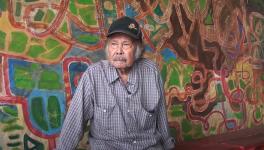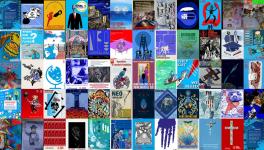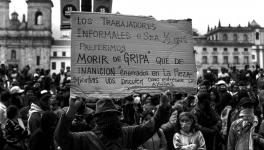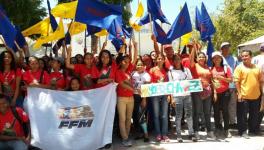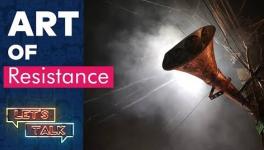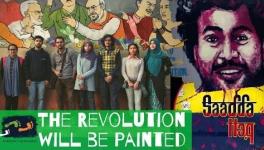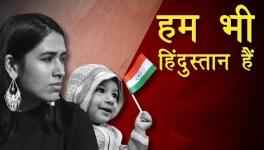The Lekra Spirit Lives: Martin Aleida on Indonesia’s Revolutionary Cultural Group
Literature that defends victims, not power.
Martin Aleida gives a testimony at the International People´s Tribunal in The Hague in November, 2015
“It was the worst when I was released. That’s the biggest prison I had to face.”
Martin Aleida recalls the moment he was released from prison at the end of 1966. The then 22-year-old writer emerged from nearly a year behind bars to a Jakarta where his friends could not be found. His workplace, Harian Rakyat (‘The People’s Daily’), the official newspaper of the Communist Party of Indonesia (PKI) was no longer. His Party and cultural organization, Lekra, was banned – and they have been illegal ever since.
Tricontinental: Institute for Social Research reached out to the now 76-year-old Martin, three months into the pandemic. Though a North Sumatra native, Martin has lived in Jakarta since the early 1960s, where he responded to us via Facebook at a local library that he frequents every Saturday.
“There are a lot of events and feelings I had gone through during the last fifty years that I couldn’t tell.” Martin first tells us about his recently published memoir, Romantisme Tahun Kekerasan (Romance in the Years of Violence). Martin, however, isn’t his name at all.
“During the 32 years of military rule under General Suharto, in order to write, I had to use a pseudonym – Martin Aleida – since as a writer I was prohibited by the authorities to write. Being accused arbitrarily and without proof that I was involved in the failed coup attempt of the September 30th Movement in 1965 (G30S) by the military, I couldn’t get back to my professional field as a writer. The same applied for thousands of teachers, civil servants, even puppet masters who were prohibited from going back to their fields, unless they were prepared to be investigated again and again with the possibility of being detained, and at worst, be eliminated.”
September 30th Movement was a military splinter group that carried out an early-morning action in 1965, resulting in the kidnapping and killing of six senior officials. Though the details of the day continue to be murky, what is clear is that the communists were scapegoated. This event served as a convenient pretext for the genocidal crackdown on PKI that was to come. Led by the US-backed General Suharto – perhaps known better to the CIA than to the Indonesian people at the time – in the short months that followed, one million communists and their sympathizers were murdered. President Sukarno – though not a communist but a great champion of the Third World project and convener of the 1955 Afro-Asian Conference in Bandung – was deposed. Suharto and his ‘New Order’ military dictatorship would stay in power for the next 32 years until 1998.
Faced with one of the bloodiest and most-silenced massacres of communists in history, Martin deepened his commitment to literature, one that, as he says, ‘defends the victims, not power’. So, assuming the penname of Martin, he wrote novels and short stories about the suffering of the people and the disappeared, and the silenced aspirations of a generation. He writes in Bahasa Indonesian – one of the Indonesian languages that was adopted as the language of the national struggle in 1928 and matured out of necessity through the anti-colonial and anti-feudal struggles of the 1930s and 1940s.
In one short story, Dewangga lives an entire marriage with Abdullah in silence, and only on her deathbed do they reveal their militant pasts to one another – him as a jailed activist in 1965, her as an organizer of landless peasants. Martin’s memoir today, he hopes, can revive these not uncommon stories of Dewangga and Abdullah for the younger generation, about life before 1965, life after, and conditions that led to this still open wound in Indonesian history.
We are the legitimate heirs of world culture.
<Amrus Natalsya, Interogasi Orde Baru (‘New Order Interrogation’), 1961.>
When they say the ‘the east was red’, it was because the east was indeed red. In 1965, PKI had three and a half million cadre and 20 million people in its mass organizations of youth, women, peasants and workers. It was the third largest communist party in the world, after the People’s Republic of China and the Soviet Union. The Institute for People’s Culture (Lekra) was one of the mass organizations with over 200,000 members, totalling 1.5 million with its supporters. Lekra was likely the largest cultural organization, not affiliated with a state, to have ever existed. Too little, however, is known about this historic organization.
As a former member, Martin recalls, “I was attracted by the organization’s point of view that literature should take a side and uphold justice of the oppressed majority – the laborers, peasants and fishermen. Literature, and art in general, are predestined to defend the oppressed.” In August of this year, Lekra would have celebrated 70 years since its founding – sharing the date of August 17th with Indonesia’s independence, a struggle that has always been intimately connected with the struggle over culture.
Rewinding two decades, Indonesia’s national liberation was born out of a cultural cry. After independence was proclaimed on 17 August 1945, the Dutch and Japanese continued to hold onto its colonial interests until 1949. Gelanggang, a group of artists associated with the Sisat weekly published its ‘Testimony of Beliefs’, a cultural manifesto for the months-young nation state:
We are the legitimate heirs of world culture, and we will perpetuate this culture in our own way. We were born from the ranks of ordinary people, and for us, the concept of ‘the people’ signifies a jumbled hodgepodge from which new, robust worlds are born. Our Indonesian-ness does not just derive from our brown skin, our black hair or our prominent foreheads, but rather from what is expressed by the form of our thoughts and feelings… Revolution for us is the establishment of new values on top of obsolete ones which must be destroyed… Our appreciation of the surrounding conditions (society) is that of people who acknowledge the reciprocity of influences between society and the artist.[i]
It was in this moment when many revolutionary cultural organizations flourished. Lekra was not only the largest but was most left-aligned. Many of its senior members were PKI cadre, including two of Lekra’s founding members – Njoto, editor of Harian Rakjat who was elected into PKI’s 5-member politburo, and D.N. Aidit, the Party’s future Secretary-General. Both of them were killed in 1965.
At Lekra’s first National Congress in 1959, Secretary-General Joebaar Ajoeb said, “Lekra was founded in 1950 due to an awareness of the essence of the August 1945 Revolution and of the connection between the Revolution and culture. An awareness that the Revolution has great significance for culture and, at the same time, culture has great significance for the August Revolution.”
From this congress, Lekra was divided into seven institutes: Literature, Fine Arts, Film, Theater, Music, Dance and Science. Through each of these artistic languages, Lekra artists sought to build a new culture, rooted in the traditional, and infused with revolutionary ideas. The cultural tasks were great and many; they ranged from systematizing popular and traditional music to identifying the decadent aspects that persisted, developing a cultural political education program to encouraging new creative production, and rediscovering ‘people’s music’ and instruments to organizing international cultural exchanges. Through its 15-year existence, Lekra not only mobilized millions, but developed cultural practices rooted in their concrete conditions. From their organizing, new expressive forms and new artistic theories emerged – they were, in essence, writing art history in the Marxist tradition.
To catch the heartbeat of those below.
<Amrus Natalsya, Mereka Yang Terusir Dari Tanahnya (‘Those Chased Away from Their Land’), 1960.>
One of Lekra’s key principles was Turun ke bawah or turba (‘descend from above’[ii]) that was concretized in the first National Congress as a theory to guide the artist-militant’s work. ‘It literally means going down to the grassroots – working, eating, living with laborers, landless peasants and fishermen’, Martin explains. Along with the ‘three alikes’ – work alike, eat alike, sleep alike – this methodology “was a way to intensify your imagination and inspiration, sharpen your feelings about how hard the lives of the people are.”
Hersri Setiawan was another Lekra member and the Indonesian representative in the Afro-Asian Writers Association in the 1960s. He was jailed on Buru Island for many years for his work with Lekra. In the documentary Tjidurian 19 – the address of Lekra’s secretariat in Jakarta raided during the crackdown – he remembers spending days hoeing and weeding and nights discussing folk tales while weaving with the peasants. To him, the purpose of an artist was to “catch the heartbeat of those below.”
Martin spoke about Amrus Natalsya, a prominent Lekra sculpturer, whose work was admired by President Sukarno and exhibited at the Bandung Conference art exhibition. Amrus lived among the Central Javanese peasants and created one of his most famous wood sculptures after a land dispute that resulted in the death of 11 landless peasants. The work was a record of an event, an analysis of class struggle, and an embodiment of the Lekra principle, kreativitas individual dan kearifan massa, combining “individual creativity and the wisdom of the masses.” The 86-year-old Amrus held his last solo exhibition in Jakarta last year entitled, Terakhir, selamat tinggal dan terima kasih (‘The last, farewell and thank you’).
But the spirit lives, if it is right.
<Viva Cuba, collection of Lekra poetry in homage to the Cuban Revolution, 1963.>
In 1959, Sukarno called upon artists to stand in the ranks of the anti-colonial and anti-imperialist fronts. He knew that developing a robust national culture must be at the same time anti-imperialist. “We must be more vigilant, more tenacious, and more persevering in opposing imperialist culture, especially US imperialist culture, which in reality continues to threaten us in every shape and way.” This was also the year of the Cuban Revolution.
In those six years before Sukarno was deposed, he was getting closer to the left flank of the Non-Aligned Movement, of which both Cuban and Indonesia were a part. They were united against imperialism and jointly organizing the Tricontinental Conference that would take place in Havana in 1966 – the very conference that we pay homage to in our own name at Tricontinental: Institute for Social Research. Neither PKI, Lekra, or Sukarno’s presidency would live to see that conference.
But history arms us. “For the younger generation it is very important to relay to them the recent past and history of the country,” Martin insists. During the 2015 International People’s Tribunal on the 1965 events, Martin testified about the crimes against humanity that he saw. When questioned about his PKI affiliation – a Party which continues to be illegal – he responded, at great risk to himself, that never regretted joining the Party when he was 20 years-old. “I am a human being, I am proud that I have ideals, even if everyone condemns what I aspire to.”
In 1966, the Afro-Asian Writers Association organized the Anti-Imperialist Caricature Exhibition in Beijing, hosting 180 works from 24 countries on the Asian and African continents. Following this lineage, Tricontinental: Institute for Social Research and the International Week of Anti-Imperialist Struggle have been organizing a series of four Anti-Imperialist Poster Exhibitions. We have had over 100 artists from 28 countries contribute work to our first two cycles themed, ‘Capitalism’ and ‘Neoliberalism’. The launch of the next poaster exhibition on ‘Imperialism’ is on October 1 and is part of a week of action against imperialism organized by hundreds of popular movements and political organizations around the world.
“Formal organizations can disappear, Party organizations can be abolished,” Lekra poet Putu Oka Sukanta reminds us, “but the spirit lives, if it is right.” We call on you to contribute art to our exhibition so that we may – in the spirit of Lekra on its 70th anniversary – combine individual creativity with the wisdom of the masses.
<S. Nar, People’s iron broom, from the Afro-Asian People’s Anti-Imperialist Caricature Exhibition, 1966>
Tings Chak is the lead designer and researcher with Tricontinental: Institute for Social Research.
[i] Translated from Goenawan Mohamad, ‘Forgetting; Poetry and the nation, a motif in Indonesian literary modernism after 1945’, 2002.
[ii] Translated by Antariksa, Sari D., Sol Aréchiga, Edwina Brennan for School of Improper Education, KUNCI Cultural Studies Center, 2018.
Courtesy: Peoples Dispatch
Get the latest reports & analysis with people's perspective on Protests, movements & deep analytical videos, discussions of the current affairs in your Telegram app. Subscribe to NewsClick's Telegram channel & get Real-Time updates on stories, as they get published on our website.









